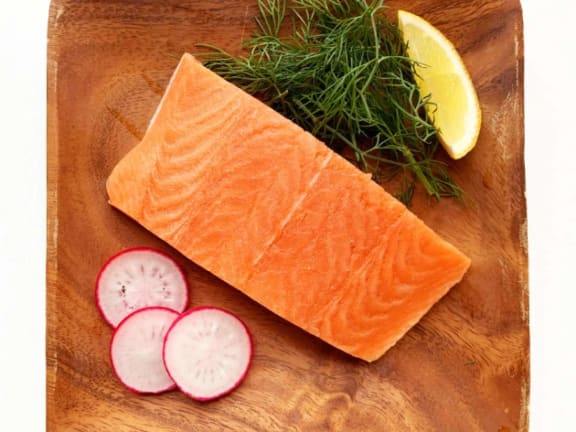5 Health-Forward Reasons Coho Salmon Should Be in Your Diet
Incorporating wild-caught Alaskan salmon into your diet has many health benefits that can have a great impact on your overall well-being. Coho salmon, a species of Pacific salmon, has unique benefits that match its nutritional profile. And thinking beyond your own health, eating fish that’s harvested from well-managed wild fisheries has a positive impact on the health of the planet.
What Is Coho Salmon & Where Is It Found?
If you like eating salmon that’s mild in flavor, consider coho your go-to fish. The flesh of coho salmon is a light reddish-orange, slightly less saturated in color than bright red sockeye salmon due to differences in diet, differences that also give it a more delicate flavor profile than sockeye. In terms of fat content, coho is more oily than a species like chum, but leaner than sockeye and chinook salmon. This fat content gives it a medium fatty texture that is pleasantly flaky.
While wild-caught coho can be found up and down the West Coast, most of the coho you find commercially are harvested from sustainably-managed fisheries in Alaska, where their population thrives.
5 Health Benefits of Incorporating Coho Salmon in Your Diet
Coho salmon shares some of the many health benefits of salmon that you’d expect to find in any wild-caught species from Alaska: it’s rich in omega-3 fatty acids, chock full of essential nutrients, has strong ties to heart health, supports brain function, and contains high levels of antioxidants like selenium and astaxanthin. And, to boot, it’s a good source of protein to add to everyday meals.
1. Great Source of Omega-3 Fatty Acids
A single 6-ounce fillet of coho salmon contains just over 900 grams of EPA and DHA. Depending on your specific dietary needs, that gets you at least halfway (or nearly all the way) to your recommended daily intake of omega-3 fatty acids.
Omega-3 fatty acids like EPA and DHA can help lower blood pressure, which is especially significant considering nearly half of the U.S. population is hypertensive. Integrating more wild coho salmon into the average American diet, then, can lead to large-scale shifts in personal and public health by helping folks manage their blood pressure through dietary choices.
Eating a diet rich in fatty fish with a balanced omega-3 to omega-6 fat content can also help manage symptoms of depression and may reduce the risk of cancer. And although dietary sources of omega-3 fatty acids do not lower your LDL cholesterol levels, they may help to manage your triglycerides.
2. High in Essential Vitamins and Nutrients
Coho salmon is a nutrient-dense source of protein, rich in vitamins and nutrients. Coho contains nearly a full day’s worth of vitamin D, more than enough vitamin B12, and moderate amounts of potassium and calcium. Enjoying plenty of wild-caught seafood in your diet is one surefire way to ensure that you are getting ample amounts of these essential vitamins and nutrients.
In addition to these nutrients, coho is also a great source of immune-boosting antioxidants that help to build a resilient immune system.
3. Good for Heart Health
Incorporating wild-caught coho salmon into your diet can help to support your health by reducing your risk of heart disease. Omega-3 fats support heart health by working against some of the mechanisms of cardiovascular disease, lowering your levels of triglycerides and raising your HDL. In addition, coho salmon’s omega-3 fatty acids may prevent deadly cases of arrhythmia.
While farmed salmon contains omega-3 fatty acids as well — in higher amounts than wild-caught salmon — the omega-6 fatty acid content of farmed salmon is also quite high. This makes for an imbalanced fat profile that isn’t ideal for health. In fact, eating a high ratio of omega-6 to omega-3 fatty acids may be problematic, as it mirrors the typical, inflammatory Western diet that is associated with highly prevalent chronic illnesses.
4. Can Improve Brain Function
Regular consumption of coho salmon and other oily fish can support brain function and brain health in people of all ages.
DHA and EPA are developmental building blocks for brain health in infants and young children. In fact, these fatty acids are so crucial to development that experts unequivocally recommend that pregnant and breastfeeding women consume low-mercury species of fish like coho salmon on a regular basis. Older children and adolescents may also see significant benefits from omega-3 fatty acids, based on research that linked fish consumption to higher grades in school.
At later stages in life, omega-3s may have a protective quality. A recent scientific review found compelling evidence that ample amounts of omega-3 fatty acids, specifically the ones found in fish oil, can help to improve cognitive function in people with mild cases of Alzheimer’s.
5. High Levels of Selenium and Astaxanthin
WIld coho salmon contains high levels of selenium and astaxanthin, potent antioxidants that round out the health benefits of this fish. A 6-ounce fillet of coho contains over 75 percent of the average adult’s recommended daily intake of selenium and about 1.2 grams of astaxanthin, a carotenoid that is abundant in wild salmon, as well as other marine creatures that are part of its food web. (Astaxanthin is what gives salmon its red hue.) Sure, these nutrients are available as supplements, but eating plenty of wild salmon means that you’re getting nutrition straight from the delicious source.
Both selenium and astaxanthin may help to support the nervous system and brain health by preventing and treating cognitive decline as we age. The two antioxidants have also been associated with a reduced risk of certain cancers. In addition, adequate selenium intake may support healthy thyroid function, while astaxanthin has been shown to improve the health of your skin.
Understanding the Benefits of Wild Caught Salmon vs. Farmed Salmon
There are notable differences between farmed and wild salmon when it comes to their nutritional profiles, how they are produced, the quality of the catch (and subsequently how they’re priced), and their impact on the ecosystem.
Wild caught salmon is the healthiest and most sustainable option, especially when you’re sourcing this fish from Alaska’s well-managed fisheries. In contrast, farmed Atlantic salmon are raised in problematic aquaculture systems that require heavy inputs of pesticides, disinfectants, and antibiotics in order to produce a viable commercial product. Some of these inputs end up contaminating the fish with toxins that are detrimental to your health and the health of the planet.
Environmental Impact
Wild salmon has a lower carbon footprint than farmed salmon, and creates less water waste than farmed fisheries. Increasing wild caught fish consumption is one of the most sustainable options for protein when you’re able to source this protein from well-managed fisheries.
Depending on the type of fish, aquaculture conditions can release high concentrations of organic waste into local ecosystems, including PCBs and dioxins, polluting the surroundings and harming neighboring species who haven’t evolved to sustain the impacts of those pollutants. Open-pen fish farms have also been the source of parasitic sea lice outbreaks that threaten wild species who exist in nearby ecosystems, as well as literal fish outbreaks where farmed and wild fish are at risk of interbreeding.
Toxins and Other Additives
Conventionally farmed salmon can be high in PCBs, or polychlorinated biphenyls, which are associated with cancer, developmental defects, endocrine disorders and a host of other diseases in humans. In fact, research suggests that farmed salmon contains more PCBs than any other food on the market, including in other land-based proteins like meat, poultry, and dairy. Farmed salmon picks up these PCBs from industrial runoff that pollutes the coastlines, where fish farms are often located, as well as from the plant-based fish feed they’re fed to mimic the nutritional profile of wild salmon. Farmed salmon also contains high concentrations of carcinogenic dioxins and chemicals from pesticides.
Since wild coho salmon has access to clean, fresh water in the open seas and wild, nutritious prey (rather than fishmeal or pellets), it’s low in the pollutants and contaminants that can plague farmed salmon, but high in naturally occurring vitamins, minerals and omega-3 fatty acids.
Where to Get High Quality, Wild Caught Coho Salmon
You can easily reap the health benefits of eating wild salmon by becoming a member of Wild Alaskan Company. A membership to Wild Alaskan Company sets you up with a box full of high-quality wild-caught coho salmon — as well as other types of salmon and white fish from Alaska — delivered straight to your doorstep each month. Learn more about how a Wild Alaskan Company membership works by visiting our homepage.






